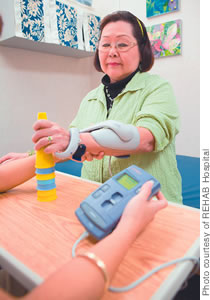
Self-care Skills For Daily Living
February 20, 2008
By Konane DeRyke


Konane DeRyke
Occupational Therapist Registered (OTR) & Clinical
Specialist for Occupational Therapy at Rehabilitation Hospital of the Pacific
Interviewed by Melissa Moniz
How long have you been working at REHAB Hospital?
Thirteen years.
Where did you receive your training?
I attended the University of Puget Sound in Tacoma, Wash.
What exactly is occupational therapy?
For inpatient rehabilitation, the focus of occupational therapy is primarily on people’s self-care skills - the activities of daily living (ADLs), for instance, grooming, dressing, bathing and toileting. We will also address homemaking skills like simple meal prep or basic household chores. We will include activities of balance, arm range of motion, and strengthening and cognitive skills into the treatments because, as patients improve in those areas, it will progress them and allow them to be more independent in the ADLs.
What is an average day like for you?
We see patients throughout the day. Ideally, we treat them twice a day. In one session, we may focus on their ADLs and either retrain them or teach them compensatory techniques that will help them adapt to their disability. In the second session, we may work on their sitting or standing balance, or an arm exercise program. Sometimes we will do cognitive retraining, too. There is a lot of carryover between all the disciplines, and we try to incorporate the goals of physical and speech therapy into our treatments.

|
What are some of the typical services you provide?
In addition to teaching them the self-care skills, we recommend the adaptive equipment and durable medical equipment. These are special aides or equipment that will allow for more independence and ease, and will maximize safety while completing their ADLs. For instance, with bathing, we normally recommend a type of shower chair, flexible shower hose, grab bars and a non-skid mat. These items will decrease their risk of falling, especially in a wet environment. Another example is a reacher. If someone has a restriction with bending at the waist, a reacher will allow them to don pants over their feet, or they can use it to reach into a high cabinet or pick up items from the floor without compromising their balance.
We also provide home evaluations when indicated. A lot of homes in Hawaii were not made for wheelchairs or walkers, so we will evaluate the entry into the home, the bedroom, bathroom, living area, even the kitchen. We will make recommendations to make the home as accessible as possible and allow them to be as independent as possible.
Does that usually require a lot of renovations?
The majority of the time we try to make simple recommendations and keep it cost-effective for the family, but still allow for it to be accessible and safe to live in.
Is family training an essential part of the therapy, or does it really depend on the patient?
Family training is critical. Families and caregivers play a vital role in ensuring a smooth transition back to the home environment. We will teach the caregiver how to assist in the ADLs, what equipment is recommended and issue a home exercise program to carry over after discharge.
Have there been any medical advancements or equipment that really helped you with working with the patients?
A little over a year ago we received a new piece of equipment called the Bioness H200 for the upper extremity. There’s also one for the lower extremity. It is a functional electrical stimulation device that uses electrodes to stimulate and activate the muscles in the hand and it works to improve hand function, voluntary movement; it increases and maintains the patients’ range of motion in their fingers. It also helps to decrease their spasticity (the tightening of the hand and fingers).
{embed=“elements/google_ad336x280”}
What are the more challenging diagnoses to treat?
All the neurological diagnoses can be challenging. Sometimes, the traumatic brain injury population may present well physically, but their cognition and safety are compromised. Some of the spinal cord injury population can be challenging because the higher the level of injury on the spine, the less physical function they have. At times, patients are still coping with accepting their injury and how it will impact their lives and those around them. We have to use different strategies with all the diagnoses.
Is it generally the same therapist who works with the same patient?
We try to keep it with the same therapist to maximize the continuity of care. Each therapist is assigned a caseload, in which we are responsible for treating the patient, monitoring their progression, recommending and ordering their equipment and ensuring the caregiver is properly trained before discharge.